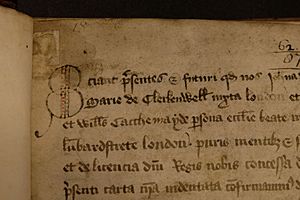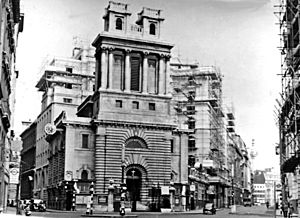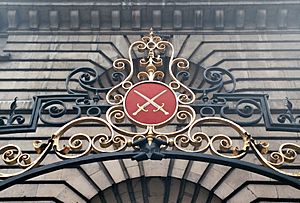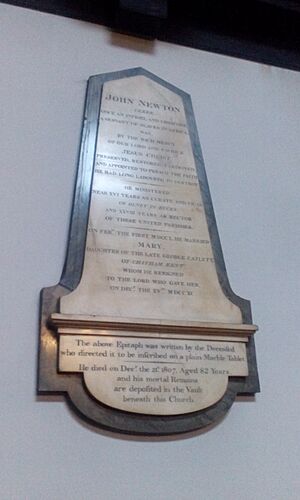St Mary Woolnoth facts for kids
Quick facts for kids St Mary Woolnoth |
|
|---|---|
| Saint Mary (Woolnoth) of the Nativity | |
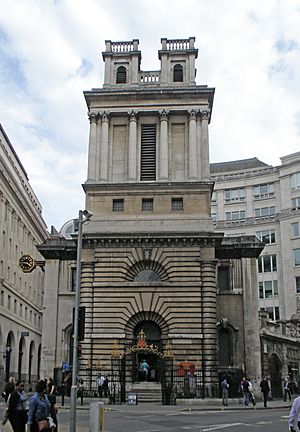
The view from the Bank end of Lombard Street (2017)
|
|
| Location | London, EC3 |
| Country | England |
| Denomination | Church of England |
| Previous denomination | Roman Catholic |
| Architecture | |
| Functional status | Regular worship |
| Heritage designation | Grade I |
| Designated | 1950 |
| Architect(s) | Nicholas Hawksmoor |
| Style | Baroque |
| Groundbreaking | 1716 |
| Completed | 1727 |
| Specifications | |
| Bells | 3 |
| Administration | |
| Deanery | City of London |
| Archdeaconry | London |
| Episcopal area | Two Cities |
| Diocese | London |
St Mary Woolnoth is an old and beautiful Church of England church in the heart of London. You can find it at the corner of Lombard Street and King William Street. This spot is very close to Bank junction, a busy area in the City of London.
The church you see today was designed by a famous architect named Nicholas Hawksmoor. It was one of the special churches built during the time of Queen Anne. St Mary Woolnoth is still an active parish church and holds regular services. For example, Holy Communion is held every Tuesday. The church is located in the ward called Langbourn.
Contents
History of St Mary Woolnoth
Early Beginnings
When the church was being rebuilt by Hawksmoor, workers found Roman remains underground. Some people think this means the site has been used for worship for about 2,000 years! This idea comes from guessing that the Roman findings were religious. They were also found under an Anglo-Saxon wooden building.
The church's name, "Woolnoth," was first written down in 1191 as Wilnotmaricherche. It is thought that "Woolnoth" comes from a person who helped the church. This might have been Wulnoth de Walebrok, who lived nearby in the 1100s. Or it could be Wulfnoth Cild, a nobleman from Sussex. The church's full name is Saint Mary of the Nativity.
The building standing today is at least the third church on this spot. The first church, built by the Normans, lasted until 1445. It was then rebuilt, and a tall spire was added in 1485. In 1666, the church was badly damaged by the Great Fire of London. Sir Christopher Wren helped to repair it. New bells were made in 1670 and 1672. However, the repaired building was not safe. It had to be taken down in 1711.
The church's old records, called parish registers, show some interesting history. They include the baptisms of two men of African origin in the early 1600s. Andrew Blackmore was baptized in 1629. Another man, Timothy, was described as a "heathen blackamoore" in 1629.
Hawksmoor's Design
The church was rebuilt as part of a big project called the Commission for Building Fifty New Churches. Work started in 1716, and the new church opened for services on Easter Day in 1727. Nicholas Hawksmoor was chosen to design it. He created one of his most unique and original buildings.
Hawksmoor was lucky because he had a lot of open space to work with. Many other churches in the City of London were surrounded by shops and houses. But these buildings around St Mary Woolnoth were taken down at the same time as the old church. This allowed Hawksmoor to use the front of the site fully. St Mary Woolnoth is the only church Hawksmoor designed in the City of London.
The church he built was a strong architectural statement. Its impressive front, in the English Baroque style, has two flat-topped towers. These towers are supported by columns of the Corinthian order, a classic style of column. These columns are used throughout the church. The side of the church facing Lombard Street has special curved sections.
Inside, the church feels surprisingly large, even though it's not huge. Hawksmoor's design creates a "cube within a cube" effect. This means a square area is surrounded by three rows of four columns. This whole section is then inside a wider square. A grand baldaquin (a canopy over the altar) is a main feature. It was inspired by the famous one by Bernini in St. Peter's Basilica in Rome.
Saved from Demolition
St Mary Woolnoth went through big changes in the late 1800s and early 1900s. It was almost torn down many times but was saved each time. In 1876, the galleries (upper seating areas) were removed by William Butterfield because he thought they were unsafe. Other important changes were made then, too.
Between 1897 and 1900, the City & South London Railway (C&SLR) built Bank Underground station right underneath the church. The railway company was given permission to demolish the church. But people were very upset, so the company changed its mind. They promised to only use the ground beneath the church. The church's crypt (underground burial area) was sold to the railway. The bones were moved and reburied in Ilford.
The church's walls and inside columns were then held up by strong steel beams. This allowed the lift shafts and staircases for Bank station to be built directly under the church floor. At this time, the church bells were also rehung. No cracks appeared in the plaster, and the building did not sink. The railway company later said the church was even stronger than before!
Modern Times
St Mary Woolnoth was named a Grade I listed building on January 4, 1950. This means it is a very important historic building. In 1952, it became a guild church.
Today, St Mary Woolnoth is the active parish church for a group of combined parishes. It is part of the Church of England's Diocese of London.
The church is currently used by the German-speaking Swiss community in London. It is also the official church in London for the government of British Columbia, Canada.
In 2013, the boundaries of the City's wards changed. Even though the buildings around it moved to other wards, the church stayed in Langbourn. This was because of its strong historical ties to that ward.
Notable People Connected to the Church
Many interesting people have been linked to St Mary Woolnoth:
- Sir Martin Bowes, a Lord Mayor and Mint Master, was married and buried here. His children and grandchildren were also baptized here.
- Thomas Kyd, a famous writer from the time of Queen Elizabeth I, was baptized here. His father, Francis, was also a churchwarden.
- Josias Shute was the church's rector starting in 1611.
- Ralph Robinson was a Presbyterian minister here in the 1640s.
- William Owtram was also a rector here.
- Thomas Busby, a composer, was the organist here from 1798.
- John Newton, a strong supporter of ending slavery and a hymn writer, was the minister here from 1780 to 1807. He wrote the famous hymn "Amazing Grace."
- William Wilberforce, another important anti-slavery campaigner, worshipped here.
- Edward Lloyd, who started Lloyd's of London, a famous insurance market, is remembered here.
- William Josiah Irons, a theologian, was the rector here from 1872.
- Sir William Phips was buried here on February 18, 1694/5.
- Anne (Marbury) Hutchinson, a well-known American colonial woman, married William Hutchinson here in 1612.
See also


